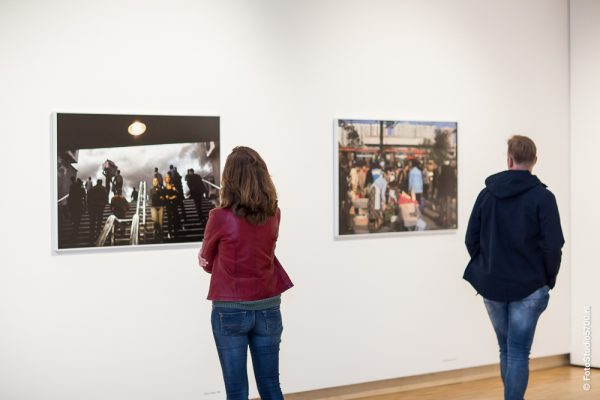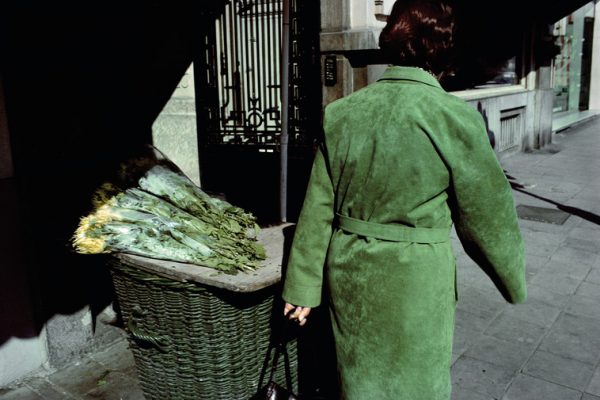
- 29 September 2020
- 19 September 2021
- Kasteel Helmond
Harry Gruyaert
Retrospective
Museum Helmond presents the first retrospective exhibition in the Netherlands of the Belgian photographer Harry Gruyaert. Gruyaert was born in Antwerp in 1941 and is considered the foremost European pioneer of colour photography. He photographs both the hustle and bustle of the streets and the quietness of a coastal landscape. His name often is mentioned in the same breath as American photographers such as Saul Leiter, Joel Meyerowitch, William Eggleston and Stephen Shore. Gruyaert has been a member of the photo agency Magnum Photos since 1982.

Richness of colour
Gruyaert first discovered the richness of colour in the 1970s. Until that time, colour photography had been exclusively reserved for advertising. In Gruyaert’s photography we see saturated colours, often with bold accents in red, green or blue. “Colour is a means, a way of sculpting what I see. Colour does not illustrate a subject or a scene, but is a value in itself”, Gruyaert once said. In addition, light and contrasts such as chiaroscuro often determine the way we experience his photographs.
The world around us
The origin of all his work is the world around us. In his choice of images, Gruyaert seems to capture the ephemeral and transient nature of this world. His photographs contain wondrous combinations of both the presence and the absence of things and people. The loneliness which characterizes part of his oeuvre is emphasized by the fact that we often do not see faces. They are covered by a shadow of a hat, they are averted, heads are photographed from behind or a head is hidden from view by a prominent balloon, for example. Part of Gruyaert’s oeuvre is steeped in melancholy.

Belgium, Liege, 1981.
Passionate photographer
Gruyaert is a passionate photographer: always looking for special locations, new subjects, motifs, light and colours. In 2018 Gruyaert told newspaper De Standaard what drives him: “I have no message, I don’t want to tell a story through my photographs. I am not a journalist/photographer. I am not looking for meaning; I only work for myself, for my own personal pleasure, my own discoveries. I am always looking for sensuality, both in light and colour. (…) For me, it is essential that the pleasure I feel in taking my photographs comes across to whoever is looking at them. And for the rest, everyone can have his or her own interpretation. For me, visual art is about emotion.”
Belgian roots
Another characteristic of Gruyaert’s work is his ability to look at the world through a surrealist lens: a tradition which presumably has its origin in his Belgian ‘roots’. Gruyaert comes from the country of surrealists like René Magritte (1898-1967), Marcel Broodthaers (1924-1976) and his contemporary Guillaume Bijl (1946). And just like the Belgian symbolist painter James Ensor (1860-1949), Gruyaert has a predilection for strong and somewhat unusual visual motifs. Ensor, for example, used masks, characters in fancy dress costumes, skeletons and grotesque parades; Gruyaert uses robes, headdresses, concealing clothing, parades (also), suddenly appearing balloons and people waiting.

Belgium, Flanders region. Town of Antwerpen, 1988, Café.
Love-hate relationship
Gruyaert often works with surprising image combinations. He frequently focuses on the fringes of his subject, never on the center of the spectacle. The photo captures an experience. The result, the eventual photograph, shows our surroundings as a fascinating fusion of the unconscious and the conscious. Perhaps the most beautiful examples of this can be found in his photographs of and about Belgium, the country he once voluntarily left but with which he subsequently developed a love-hate relationship. His photographs of Belgium bring together many of the typical Gruyaert features, such as banality, surrealism and the power of tradition.
Double projection
‘Harry Gruyaert – Retrospective’ will show more than 120 photographic works. For example, the exhibition will include the various series he made in Las Vegas, Russia, Morocco, India and of course Belgium. And there will be a wide selection of ‘Rivages’, his acclaimed series dedicated to coastal landscapes. The exhibition furthermore features a number of digital slide projections rhythmed by music: the recent double projection ‘Made in Belgium’, the fascinating series ‘Last Call’ about airports, the poetic series ‘Irish Summers’ and the recent documentary about the photographer, released in 2019.
Biography
Gruyaert studied photography and film in Brussels, and first started out as a director for Flemish television. He was not a team player, so he soon opted for a career as a photographer. He moved to Paris. In 1972 he made the remarkable series “TV-SHOTS” in London. Colour photographs of world events, such as the landing on the moon or the Olympic Games, were shown in the never-before-seen intense colours of colour television. Centre Pompidou bought this important series for their collection. As soon as 1976 Gruyaert won the Kodak Award. That same year, he recognized a kindred spirit in William Eggleston. Eggleston’s 1976 solo exhibition in the Museum of Modern Art in New York regularly is seen as the breakthrough of colour photography in serious photography in the USA. Around 1980 Gruyaert already had made several photo series in the United States, India, Egypt, Japan and Morocco. In 1982 he became a member of the prestigious photo agency Magnum Photos. Although Gruyaert publishes his photo series in books, he mainly works intuitively and prefers to see each photo as a separate entity. In recent years Gruyaert has been honored with major retrospectives in Paris, Toulon and Antwerp.
Museumshop
In our museum shop a number of special publications on Harry Gruyaert will be for sale.




